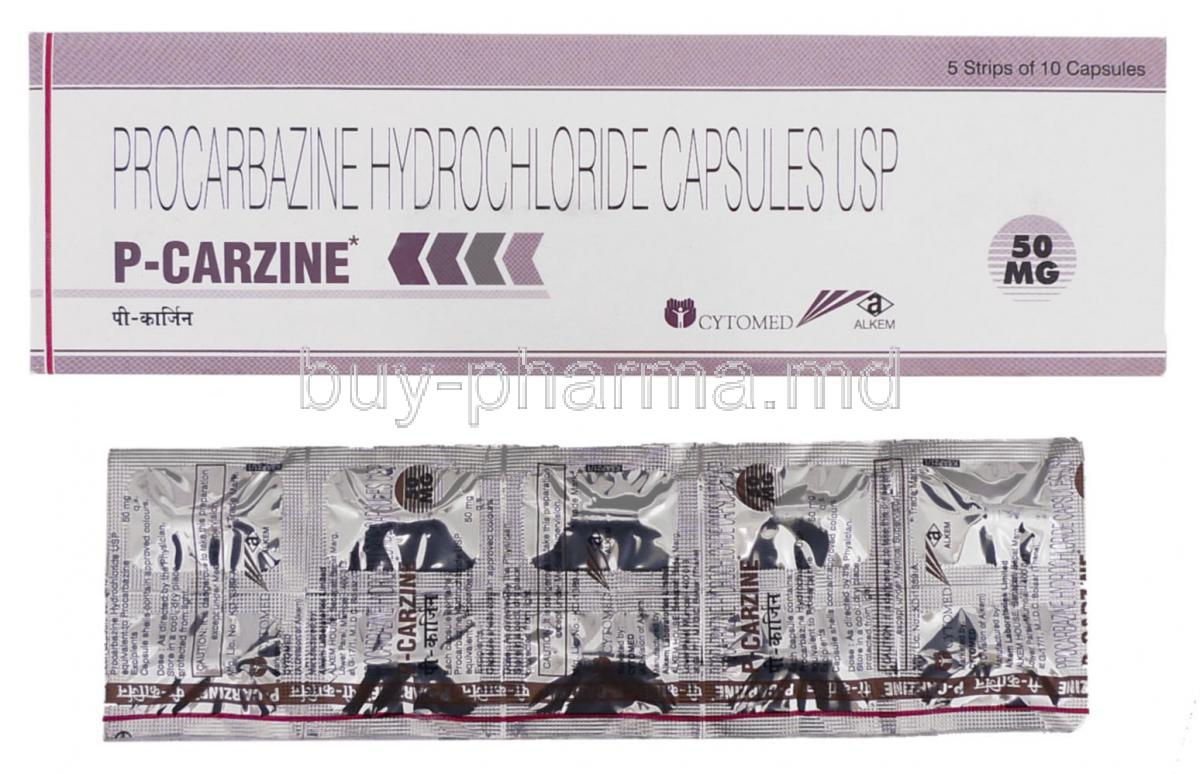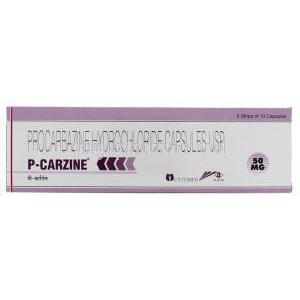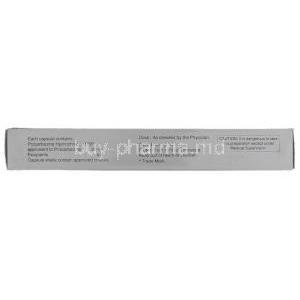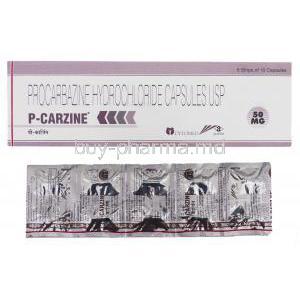Introduction to P-Carzine (Procarbazine HCL)
P-Carzine, containing Procarbazine Hydrochloride, is a potent antineoplastic agent primarily classified under the alkylating group of chemotherapy drugs. It plays a critical role in oncology as a cytotoxic agent designed to disrupt malignant cell proliferation. Initially developed in the 1960s, Procarbazine became an essential part of the renowned MOPP regimen for Hodgkin’s lymphoma treatment.
Approved by the FDA decades ago, Procarbazine continues to hold a prominent place in combination chemotherapy protocols worldwide. It is marketed under several trade names, including Matulane in the United States and P-Carzine in international markets, ensuring global accessibility for cancer treatment programs.
In modern oncology, Procarbazine remains a cornerstone drug for its versatility in combination therapy, synergizing effectively with agents such as mechlorethamine, vincristine, and prednisone to enhance remission rates in lymphoid malignancies.
Composition and Formulation
The key active ingredient in P-Carzine is Procarbazine Hydrochloride. This compound belongs to a class of methylhydrazine derivatives with powerful alkylating and antimitotic effects. Chemically, it is characterized by its molecular formula C12H19N3•HCl, offering both lipid and water solubility for efficient systemic absorption.
P-Carzine is formulated in oral capsule form, typically available in 50 mg strength, allowing for flexible dosing schedules based on individual therapeutic requirements. Inactive excipients may include lactose, starch, magnesium stearate, and gelatin, all contributing to capsule stability and dissolution consistency.
Mechanism of Action: How Procarbazine Works
Procarbazine functions through multiple pharmacodynamic mechanisms. Its alkylating properties allow it to bind to DNA strands, causing single-strand breaks and inhibiting cellular replication. This interference prevents the synthesis of nucleic acids essential for tumor growth.
Additionally, Procarbazine hampers protein and RNA synthesis, exerting cytotoxic stress on neoplastic cells. It also generates reactive oxygen species that induce oxidative damage, leading to apoptosis or programmed cell death. The compound’s dual mechanism—DNA alkylation and free radical formation—makes it highly effective in combination chemotherapy regimens such as MOPP or COPP.
- Inhibits mitotic progression in rapidly dividing cancer cells
- Interrupts enzyme systems essential for tumor metabolism
- Enhances the therapeutic efficacy of other antineoplastic agents
Clinical Uses and Indications
Primary Uses
- Hodgkin’s Lymphoma: A standard component of the MOPP regimen, combining mechlorethamine, vincristine, and prednisone for optimal remission.
- Non-Hodgkin’s Lymphoma: Occasionally utilized as part of multi-drug chemotherapy protocols.
Additional Oncology Uses
- Brain Tumors: Effective against glioblastoma multiforme and astrocytoma when combined with radiation therapy.
- Ovarian Carcinoma: Investigational use in advanced-stage malignancies.
- Small Cell Lung Carcinoma: Part of combination protocols targeting aggressive tumor growth.
Off-Label and Experimental Uses
- Melanoma and Sarcomas: Studied for its cytotoxic potential in refractory cases.
- Combination Chemotherapy Trials: Explored with temozolomide and nitrosoureas for enhanced efficacy.
Dosage and Administration Guidelines
For Hodgkin’s disease, the usual dosage in the MOPP protocol begins at approximately 100 mg/m²/day for 14 consecutive days, followed by rest periods. The exact dosage depends on the patient’s body surface area, age, and hematologic profile.
- Adults: Typical range 2–4 mg/kg/day orally, adjusted per tolerance.
- Adolescents: Dosed similarly with strict monitoring of bone marrow function.
Capsules are administered orally, preferably after meals to minimize nausea. Alcohol and foods rich in tyramine should be avoided due to Procarbazine’s mild monoamine oxidase inhibitory (MAOI) effect. Regular monitoring of blood counts and liver function is essential throughout therapy.
Side Effects of P-Carzine
Common Side Effects
- Nausea, vomiting, and appetite loss
- Fatigue and transient drowsiness
- Headache and dizziness
- Taste alteration and dry mouth
Serious Adverse Reactions
- Myelosuppression: Manifested by anemia, leukopenia, or thrombocytopenia
- Peripheral Neuropathy: Numbness or tingling in extremities due to neuronal toxicity
- Hepatotoxicity: Elevated liver enzymes or jaundice during prolonged therapy
- Neurotoxicity: Disorientation or convulsions in high-dose exposure
- Serotonin Syndrome: Rare but possible when combined with MAOIs or serotonergic agents
Drug Interactions
- Monoamine Oxidase Inhibitors (MAOIs): Co-administration increases risk of hypertensive crisis.
- Tyramine-Rich Foods: May precipitate dangerous elevations in blood pressure.
- Alcohol and CNS Depressants: Enhance sedation and neurotoxicity risk.
- Other Chemotherapy Agents: Potential for additive myelosuppressive effects.
- Fertility Treatments: May interfere with hormonal balance and sperm production.
Warnings and Precautions
Patients must undergo frequent complete blood counts (CBC) and hepatic function tests to detect early toxicity. Alcohol consumption and foods containing tyramine—such as aged cheese, cured meats, and red wine—must be strictly avoided due to potential MAOI-like reactions.
Prolonged therapy carries a small risk of secondary malignancies, emphasizing the need for long-term surveillance. Mood alterations and depressive symptoms may occur, requiring prompt clinical evaluation. Caution is also advised in patients receiving concurrent radiation or cytotoxic drugs to prevent cumulative toxicity.
Contraindications
- Known hypersensitivity to Procarbazine or related compounds
- Pre-existing severe bone marrow suppression
- Significant hepatic or renal impairment
- Pregnancy and lactation due to teratogenic potential
- History of psychiatric illness or previous MAOI therapy
P-Carzine must only be administered under the supervision of an experienced oncologist. Proper monitoring and dietary compliance are critical to achieving safe and effective outcomes during cancer therapy.
Careful Administration and Monitoring
Effective and safe administration of Procarbazine Hydrochloride (P-Carzine) requires vigilant medical supervision and ongoing clinical monitoring. Before initiating therapy, a baseline evaluation of hematologic parameters is essential to determine the patient’s bone marrow reserve and detect any pre-existing cytopenias.
Throughout treatment, physicians must conduct continuous surveillance for potential infections or bleeding tendencies. Even minor symptoms such as sore throat, fever, or unexplained bruising may indicate the onset of myelosuppression and warrant immediate medical attention.
- Renal and Hepatic Adjustment: Dose reduction is often required in patients with impaired kidney or liver function to minimize drug accumulation and systemic toxicity.
- Neurotoxicity Monitoring: Persistent dizziness, confusion, or peripheral neuropathy may suggest cumulative neurotoxic effects. Regular neurologic evaluations are advised for early detection.
- Long-Term Carcinogenic Risk: Extended use of Procarbazine has been associated with a risk of secondary malignancies, particularly leukemia, necessitating periodic long-term follow-up even after treatment cessation.
Special Populations and Administration Considerations
Administration to Elderly Patients
Geriatric patients exhibit heightened sensitivity to the hematologic and hepatic effects of P-Carzine. Their diminished organ clearance often results in prolonged systemic exposure and elevated risk of toxicity.
- Initiate therapy with reduced doses and titrate cautiously.
- Perform frequent liver and renal function assessments to guide dosage modifications.
- Be alert for myelosuppressive effects that can manifest earlier and more severely in elderly populations.
Administration to Pregnant Women and Nursing Mothers
Procarbazine demonstrates teratogenic and mutagenic potential in animal studies, reflecting a risk of fetal harm. Consequently, it should only be administered during pregnancy in life-threatening cases where no safer alternative exists.
- Pregnancy Avoidance: Effective contraception is mandatory during treatment and for several months thereafter.
- Breastfeeding: The drug may be excreted in breast milk; hence, nursing must be discontinued during therapy to prevent infant exposure.
Administration to Children
In pediatric oncology, dosing of Procarbazine is determined by body surface area (mg/m²) to ensure accurate therapeutic exposure while minimizing toxicity. Children are particularly vulnerable to hematologic suppression and require meticulous monitoring throughout treatment.
- Frequent complete blood counts to assess bone marrow activity.
- Observation for growth retardation or developmental delays in long-term survivors.
- Evaluation for secondary malignancies, especially when used in combination with radiation or other alkylating agents.
Overdosage and Toxicity Management
Acute overdose of P-Carzine presents as a medical emergency. Common manifestations include severe nausea, uncontrollable vomiting, profound confusion, and bone marrow suppression. Prompt medical intervention is vital to mitigate systemic toxicity.
- Immediate Actions: Initiate gastric lavage or activated charcoal administration to limit absorption.
- Supportive Care: Maintain hydration and electrolyte balance to support renal clearance.
- Hematologic Support: Administer blood transfusions or colony-stimulating factors as needed.
- Organ Monitoring: Continuous evaluation of hepatic, renal, and central nervous system function is essential during recovery.
Handling and Storage Precautions
P-Carzine should be stored at controlled room temperature, away from excessive moisture and direct sunlight. It is crucial to maintain the integrity of the capsules by keeping them in tightly closed containers.
- Healthcare Provider Safety: Procarbazine is a cytotoxic agent; gloves and protective equipment must be worn when handling.
- Disposal: Unused capsules and contaminated materials should be disposed of following biohazard and cytotoxic waste protocols.
- Accidental Exposure: In case of skin or mucosal contact, rinse thoroughly with copious amounts of water and seek medical evaluation if irritation persists.
Important Patient Guidance
Patients undergoing therapy with P-Carzine should be provided with comprehensive counseling regarding drug safety and lifestyle modifications.
- Dietary Restrictions: Avoid foods containing high levels of tyramine, such as aged cheese, cured meats, and red wine, to prevent hypertensive reactions.
- Symptom Reporting: Promptly report signs of infection, bleeding, or unusual fatigue to healthcare providers.
- Activity Caution: As Procarbazine may induce drowsiness or dizziness, refrain from driving or operating heavy machinery.
- Treatment Adherence: Maintain consistent dosing schedules and do not discontinue therapy without physician approval.
- Contraception: Use effective birth control during treatment and for several months after completion to prevent potential teratogenic exposure.
Summary and Clinical Outlook
Procarbazine Hydrochloride remains an integral component of combination chemotherapy regimens, particularly for Hodgkin’s lymphoma and select brain tumors. Its cytotoxic efficacy, while formidable, necessitates diligent monitoring and individualized dosing strategies to mitigate adverse outcomes.
In current oncology practice, P-Carzine continues to demonstrate therapeutic relevance, especially when incorporated into multidrug protocols that enhance response rates and remission durability. Ongoing research explores its potential synergy with newer targeted agents and immunotherapies, seeking to refine treatment precision and reduce long-term toxicity.
Ultimately, the long-term prognosis for patients treated with Procarbazine depends on vigilant follow-up, comprehensive patient education, and adherence to clinical safety protocols, ensuring a balance between efficacy and quality of life.





